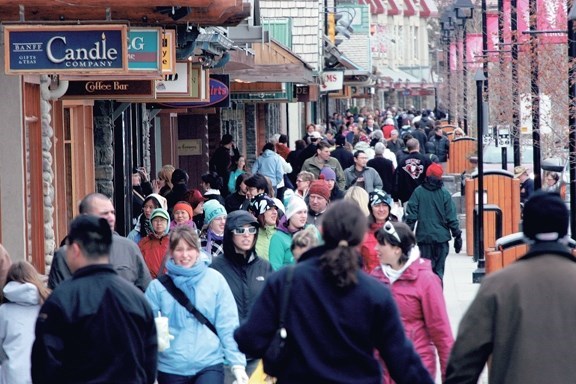BANFF – Visitation to Banff National Park edged upwards over summer, but new forecasts suggest the tourism industry might not fully bounce back from the global COVID-19 crisis until 2026.
Local tourism industry officials say hotels in Banff and Lake Louise were just 27 per cent full in June, before moving to 53 per cent occupancy in July and 63 per cent full in August – compared to about 90 per cent in peak summer months in pre-pandemic years.
“There’s a slight improvement over 2020, but still nowhere near the 2019 numbers,” said Leslie Bruce, president and CEO of Banff Lake Louise Tourism (BLLT).
“What I see are incremental gains, still a trepidation, but we’re still nowhere back to a sort of normal mindset.”
A spring study by Destination Canada forecasted tourism recovery to 2019 levels is not expected until 2026.
“We are seeing that unfold right here in front of us in Banff National Park,” said Darren Reeder, executive director for Banff and Lake Louise Hospitality Association (BLLHA).
September’s industry statistics for Banff aren’t yet in, but Reeder said early signs show some improvement over last year’s hotel occupancy.
That said, Reeder noted there is no question the visitor spend has been far lower than pre-pandemic figures.
“Even with some improvements in occupancy, this doesn't necessarily convert into revenue,” he said.
“It’s still strikingly low for operators compared to the pre-pandemic levels and there is still a long way to go in terms of our recovery.”
Reeder said the tourism industry is grateful, and absolutely depends on the contributions of Albertans and regional visitors, but about eight Alberta visitors are needed to offset the loss of one international visitor.
He said international travellers – which make up about half of the visits to the park during a pre-pandemic year – have not returned to Banff National Park en masse quite yet, even though the Canadian border reopened to vaccinated global travellers on Sept. 7.
“It takes time to plan longer-haul travel, but we look forward to welcoming them back,” he said.
Even though the border opened to vaccinated Americans on Aug. 9, Bruce said not as many visited Banff and Lake Louise as predicted.
“We saw an initial uptick a few weeks after the border opened, but it really hasn’t been to the extent that we thought it would,” she said.
“I think that’s in large measure due to confusion that Americans have around the border and the difference we’re seeing between the American messaging and the Canadian messaging.”
Heading into winter, Bruce said businesses are counting on a strong ski season with Mother Nature’s cooperation with plentiful snow.
But, she said, the region is still not seeing the level of advance google search interest or bookings as hoped for, though she said that’s picking up for January 2022.
“There’s certainly hope that the tides will turn on that,” she said, noting BLLT is testing different marketing approaches and messaging on what people need to feel confident to travel.
“We’re kind of thinking there’s a mindset around 2021 where people are still not super confident to book in 2021, but thinking that things might look better in 2022.”
While hotel occupancy data isn’t in for September yet, the Town of Banff has released its two-way vehicle volume counts for the month for both entrances to town.
Vehicle volumes were 573,033, a 20 per cent increase from September 2020 volumes, a nine per cent decrease from 2019, and a 13 per cent decrease from 2017, which was the highest September volume on record.
Officials say that both the Banff Marathon and Melissa’s road races were not held in 2020 due to the pandemic, but both kicked off in September 2021, contributing in part to the increase in traffic volume.
Bruce said the traffic counts, which typically represent the day visitors, are another leading indicator that tourism may be starting to come back.
“I know that traffic can also be associated with congestion, but as it relates to a signal that people are willing to travel or willing to come out and to engage, this was actually really good news,” she said.
Adrian Field, the director of engineering for the Town of Banff, said it was good to see the traffic numbers from a visitation perspective, but noted there were 16 days in July and August when Banff’s roads were beyond the congestion threshold of 24,000 vehicles per day.
But he said the introduction of paid parking, in combination with Liricon’s 500-stall free parking intercept lot at the train station as well as additional stalls at the Fenlands recreation centre, were a game-changer.
“Our big learning for the year is paid parking had achieved everything we wanted it to achieve in terms of filling up the intercept lots, emptying out parking in residential streets and freeing up parking spaces downtown,” he said.
“Intercepting vehicles in the parking lot is a huge win,” he said, adding at least 1,500 vehicles parked at the train station on the busiest of summer days, sometimes spilling over into the gravel parking area.
Building on the August visitation numbers, Bruce believes September was quite strong too, but said that will be confirmed once data comes in.
“Anecdotally, we’ve definitely heard that although the fourth wave was really in full force in September, that there was still enough activity in September,” she said.
“The summer in the end finally picked up momentum in August. It was a very slow start in June, July was not as strong as we had forecasted, but August definitely started to show those signs of recovery that we’ve been looking for.”




